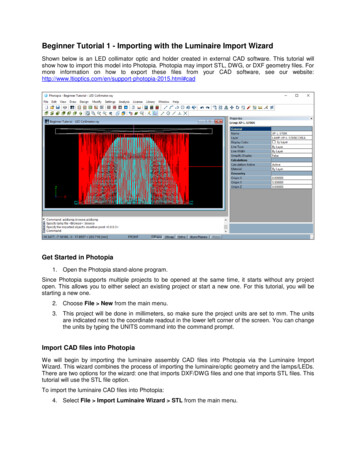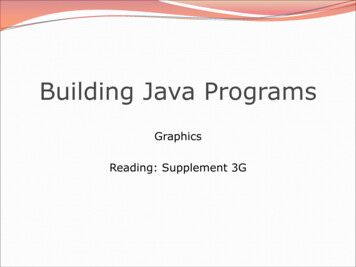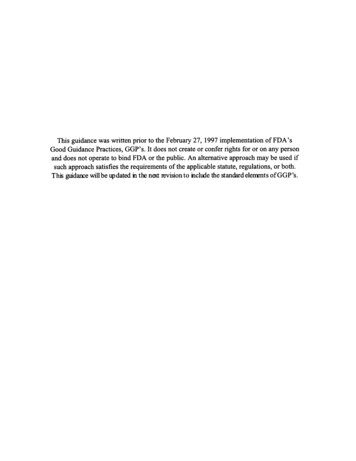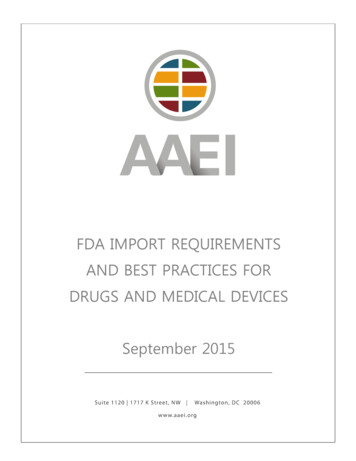
Transcription
FDA IMPORT REQUIREMENTSAND BEST PRACTICES FORDRUGS AND MEDICAL DEVICESSeptember 2015
FDA Import Requirements andBest Practices for Drugs andMedical Devices
FDA Import Requirements and Best Practices for Drugs and Medical DevicesTable of Contents1.2.3.4.5.6.7.8.9.10.11.12.13.Introduction and Abbreviation Table . 3Importation Process Diagram . 6PREDICT . 6MARCSa. Data Transmission Requirements . 8b. FDA Establishment Registration . 12OASIS. 12Import Trade Auxiliary Communications System (ITACS) . 13Drugsa. What is a drug? . 14b. What is an unapproved drug? . 14c. Drug Development & Steps Toward Drug Approval . 14d. API Importation. 15e. Drug Listing . 18f. Drug Labeling for Importation . 21g. R&D Human Use/Investigational Samples . 22h. R&D Non-Human Use (Unapproved) . 24i. Non-human Use (Approved and Unapproved) . 25Devices . 26Vaccines and Biologics – CBER Products . 31FDA Review Statuses & Responding to FDA Detentiona. FDA Review Statuses. 32b. Responding to FDA Detention . 33Import Alerts . 35Special Situationsa. Import for Export. 36b. PLAIR . 38c. Foreign Trade Zone . 40d. Returned of U.S. Pharma . 41e. Prior Notice. 42Appendixa. Constructing the Manufacturer Code . 44b. FDA Product Code Builder . 46c. FDA’s Integration to the Automated Commercial Environment (ACE)/International TradeData Systems (ITDS). 49d. Violation Code Translations. 53e. Website Links . 54-2-
FDA Import Requirements and Best Practices for Drugs and Medical Devices1a. IntroductionA cross-functional team from branded and generic pharmaceutical and medical device companiesprepared this manual in order to assist the U.S. importer of FDA regulated merchandise. Compliance to theFDA’s import regulations and processes continues to be a core competency for U.S. importers as supplychains expand and become more complex. This manual should be utilized as one of many tools in animporter’s tool box for compliance with U.S. Participating Government Agencies with import jurisdiction.This manual serves as a reference source and not meant to provide any legal or regulatory advice.Please note that the abbreviation FD&C Act refers to the Food, Drug & Cosmetic Act.1b. Abbreviation tableABIAutomated Broker Interface (with CBP)ACEAutomated Commercial EnvironmentACCAccession NumberACSAutomated Commercial System (CBP)AofCAffirmation of Compliance codes (for FDA)ANCAnnual Report Accession NumberANDAAbbreviated New Drug ApplicationAPIActive Pharmaceutical IngredientBLABiologics License ApplicationCBERCenter for Biologics Evaluation and ResearchCBPCustoms & Border ProtectionCDERCenter for Drug Evaluation and ResearchCFRCode of Federal RegulationsCMContract ManufacturerCMCChemical Manufacturing ControlCPTComponent of DeviceDEVForeign Manufacturer Registration NumberDIIInitial Importer Registration NumberDIOPDivision of Import Operations and Policy (FDA)DLSDrug Listing number-3-
FDA Import Requirements and Best Practices for Drugs and Medical DevicesDUNSData Universal Numbering System; Dun and BradstreetFDAFood and Drug AdministrationFD&C ActFederal Food, Drug, & Cosmetic Act (FDA)FEIFacility Establishment Identifier number (FDA)FPFinished ProductFTZForeign Trade Zone (US CBP Regulated)HDEHumanitarian Device ExemptionHPUSHomeopathic Pharmacopoeia of the United StatesIDEInvestigational Device ExemptionIFEImport For Export (FDA)INDInvestigational New DrugISOInternational Standards OrganizationITACSImport Trade Auxiliary Communications SystemLSTDevice Listing NumberMARCSMission Accomplishment and Regulatory Compliance ServicesMIDManufacturer Identification codeNDANew Drug ApplicationNDCNational Drug CodeNFNational FormularyOASISOperational and Administrative System for Import Support (FDA)ORAOffice of Regulatory Affairs (FDA)OTCOver The CounterPDPProduct Development Protocol numberPLAIRPre-Launch Activities Importation RequestPLDPrivate Label DistributorPMAPremarket Approval numberPMNPremarket Notification number-4-
FDA Import Requirements and Best Practices for Drugs and Medical DevicesPNPrior Notice (FDA)PREDICTPredictive Risk-based Evaluation for Dynamic Import Compliance Targeting toolREGDrug Facility Registration NumberSPLStructured Product LabelingTPMThird Party ManufacturerUSDAUnited States Department of AgricultureUSHTSUnited States Harmonized Tariff ScheduleUSPUnited States PharmacopoeiaXMLExtensible Markup Language2. Importation Process Diagram-5-
FDA Import Requirements and Best Practices for Drugs and Medical Devices3. PREDICTPREDICT is the FDA’s Predictive Risk-based Evaluation for Dynamic Import Compliance Targeting tool;which is integrated within the MARCS entry review system. Its intent is to prevent the entry of adulterated,misbranded, or otherwise violative goods while expediting the entry of compliant goods.PREDICT will improve FDA enforcement targeting by scoring each entry line on the basis of multiplefactors, increasing the number of “May Proceeds” that are issued for lower risk line items (more compliant) ,and providing reviewers with line scores and the rationale behind the scores for those items assigned furtherreview. PREDICT shifts the focus of FDA reviews from “entries” to “line items”. This is accomplished by usingautomated data mining and pattern discoveries to develop rules in conjunction with open-source intelligence.PREDICT will query databases for relevant information such as facility registrations, drug listings, marketapprovals, etc. Source data may include field exams, sample analyses, results of foreign and domestic facilityinspections, product code and facility code accuracy, data anomalies in transmitted information, andadmissibility history (importer, exporter, manufacturer and ultimate consignee). Importers should be awarethat providing consistent and accurate information (e.g. FDA Product Codes, AofCs, and FDA ManufacturerIdentification code) will expedite PREDICT’s line item screening.4. MARCSMARCS manages the integration, reengineering and enhancement of several legacy systems tobetter support FDA's mission.MARCS Imports Entry Review is a web-based application for conducting entry review that includesthe following enhancements:A. Predictive Risk-based Evaluation for Dynamic Import Compliance Targeting (PREDICT)screening module;-6-
FDA Import Requirements and Best Practices for Drugs and Medical DevicesB. Integration with Import Trade Auxiliary Communications Service (ITACS);C. Entry and line level access to a menu of pre-defined reports that provide information onpast import examination results;D. Enhanced User Preferences.The entry reviewer will either provide a “May Proceed”, request additional information, or forward toa Compliance Officer. The Compliance Officer may resolve the entry with requesting additional information,granting a “May Proceed”, requesting a field exam, or refusing the shipment.Field work and detention requests are processed through the MARCS system. Once the entry linesare set up for field work or the detention request has been processed the entry lines are then populated inOASIS to be assigned.4a. MARCS Data Transmission Requirements Required Data Elements:Five specific data elements (A-E) must be transmitted for FDA admissibility: Examples given below arefrom the FDA Product Code Builder Tutorial.A) Commercial Description: The commercial description is an actual description of the product, usuallyobtained from the invoice. Therefore, the invoice must have a correct description; i.e., Trade name, Genericname, Potency, Dosage Form and Packaging Configuration.B) FDA Manufacturer: The FDA manufacturer is the physical location at which the product is manufacturedor produced. The name and address of a corporate headquarters or intermediate supplier is not acceptable.U.S. Customs and Border Protection (CBP) requires declaration of the "invoicing firm," which may not be themanufacturer. For example: ABC Co, in Hong Kong manufacturers a finished drug product under contract for XYZ Corp. inPeoples Republic of China. XYZ Corp. invoices and ships the product to the U.S. RESULT: FDA considers ABC Co. to be the manufacturer; CBP considers XYZ Corp. to be themanufacturer.If the same item is produced by multiple manufacturers, each manufacturer must be shown as aseparate line item by quantity and the FDA elements for each must be submitted. Reference the Appendixfor the FDA Manufacturer Identification (MID) code construction. Another facility requirement is the facilityannual registration with the FDA (called FEI or CFN).C) FDA Shipper: The FDA shipper is the actual shipper of the product being imported. The FDA shipper isoften identical to the invoicing party reported to CBP. Human drugs, medical devices, and biologics mustalways show evidence of being produced in a FDA registered facility. (Facility Establishment Identifier number(FEI).Only if a product being imported is not subject to registration, listing or licensing and the FDAManufacturer information is not available (after the importer has made a good-faith effort to obtain theinformation), may the FDA Shipper information be transmitted in lieu of the FDA Manufacturer information. Inthis case, the FDA country of origin remains the country of the site-specific manufacturer. Reference theAppendix for the FDA Manufacturer Identification (MID) code construction.D) FDA Country of Origin: The FDA Country of Origin is needed for electronic screening. FDA considers thecountry of origin to be that of the actual manufacturer of the final drug product. CBP considers the country oforigin to be the last location of substantial transformation. Most of the time the last location of substantialtransformation is the API manufacturing location. For example:-7-
FDA Import Requirements and Best Practices for Drugs and Medical Devices ABC Co. in Japan manufactures an API, which is used in the manufacture of tablets by XYZ Corp. inKorea.FDA regulates both the API and drug product, but considers the country of origin to be Korea, wherethe tablets were manufactured.CBP considers Japan to be the country of origin because this is the last location of substantialtransformation .When 2 or more active ingredients are combined in manufacturing, FDA and CBP both typically consider thecountry of origin to be that of the actual manufacturer of the final drug product.Suggestion: For assistance with CBPs country of origin determination, contact your internal Trade Compliance,Legal department, consulting firm or Customs representative.E) FDA Product Code: A FDA Product Code is “built” from the FDA product code builder found on the pcb.htm). It is a 7 character, alpha-numeric code thatindicates, among other things, the action of the drug, the active ingredients, the final dosage form,human/animal/investigational use, and prescription requirements. Reference the Appendix for the FDAProduct Code builder.Optional Data Elements:Optional information may be declared in OASIS, when applicable. Providing additional FDA data willhelp expedite the review process. Examples of four (A-D) optional data elements are below.Affirmation of Compliance Codes (AofC): The AofCs help the FDA evaluate the import by furtherdefining the import. The FDA validates the AofCs provided against various FDA databases. Ifaccurate A of C’s are provided the entry may pass the new system auto look-up and may be “MayProceeded” by the system. If the entry does not pass auto look-up then it will be manually reviewedby an Entry Reviewer. If the A of C information has been supplied, the entry reviewer may be ableto release the entry during their initial review. If A of C codes are not provided, the entry will not passauto-look, and will require documents to be submitted for review by an Entry Reviewer.A of C Codes to provide for drugs: Regulatory Filing Number (NDA, ANDA, BLA, IND, etc.) DLS (Foreign Drug Listing #) NDC (U.S. Drug Listing #) Drug Facility Registration Number (REG)A of C Codes to provide for devices: Foreign Manufacturer Registration Number (DEV) Device Listing Number (LST) Foreign Shipper Registration Number (DFE) Initial Importer Registration Number (DII) Premarket Notification Number or 510K (PMN) - for Class IIDevices only Premarket Approval Number (PMA) – for Class III Devices onlyA of C Codes to provide for device components: Component of Device (CPT) Device Listing Number (LST) and Initial Importer RegistrationNumber (DII) of the finished device FDA Product Code of finished deviceA of C Codes to provide for Radiological Health Devices: Accession number (ACC) Annual Report Accession number (ANC) Model Number (MDL) Component (CPT)(See Appendix E, Useful Links, page 41)-8-
FDA Import Requirements and Best Practices for Drugs and Medical DevicesEach product’s HTSUS code and FDA Product Code will indicate the need for registration andlisting. When the HTS code for a product which may be under FDA jurisdiction is submitted to CBP,it directly triggers one of the following FDA "flags" in ACS: FD0, FD1, FD2, FD3 and FD4. The flagprovides an indication of whether products are or may be under FDA jurisdiction, whether prior noticeor other entry information is required, and the basis to “Disclaim” a product from FDA notificationrequirements.FD0 - Indicates that FDA has determined the article, even though subject to FDA's laws andregulations, is acceptable for CBP release without further presentation of prior notice or other entryinformation to FDA.FD1 - Indicates that the article may or may not be subject to FDA jurisdiction, including FDA reviewunder 801(a) of the FD&C Act. For products not subject to FDA jurisdiction based on their intendedend use, a filer can "Disclaim" the product from FDA notification requirements. The FDA willperiodically review “Disclaimed” entries to confirm the accuracy of the declaration.FD2 - Indicates that the article is under FDA jurisdiction and review of entry information by FDA undersection 801(a) will take place. However, the article is not "food" for which prior notice information isrequired.FD3 - Indicates that the article may be subject to prior notice under section 801(m) of the FD&C Actand 21 CFR Part1, subpart I. , e.g., the article has both food and non-food uses.FD4 - Indicates that the article is "food" for which prior notice is required under section 801(m) of theFD&C Act and 21 CFR Part1, subpart I.Exceptions to registration and listing include: Inactive ingredients and excipientsIntermediates (non-API)Drug products not intended for importation into the United States (ForeignTrade Zone, FTZ)Drugs imported under an Investigational New Drug (IND) Application (21C.F.R. 312)Components of drugs imported under 801(d)(3), Import for Export (IFE).Quantity: Quantity data provides additional information to FDA about the product and how it is packaged. Thebasic format for Quantity Data is in multiple pairs of data – quantity and unit of measure, i.e., 500 cases, 12ounces, fluid, 1000 cartons, etc. Up to 6 data pairs may be submitted. The first pairs describe the containers.The last pair must describe the amount of product in the smallest container. Here are some examples:Product: 1000 cases of mineral water, 24/12 ounce bottles in each caseData pairs: 1000 CS (Case)24 BO (Bottle, Non-protected, Cyl)12 FOZ (Ounces, fluid)Product: 200 cartons of 100 rolls surgical gauze, 75 square yards per rollData pairs: 200 CT (Carton)100 RO (Roll)75 SYD (Square Yards)Product: 100 cartons of 24 aspirin bottles, 100 tablets, 325 mg.Data pairs: 100 CT (Carton)24 BO (Bottles, Non-protected, Cyl)100 TAB (Tablets)Quantity for bulk drug product examples:Product: 10 drums of 15kg API (All drums are the same Kg weight)10 DR-9-
FDA Import Requirements and Best Practices for Drugs and Medical Devices15KGProduct: 10 drums of 15kg API and a drum of 5kg (drums of various weights)155kg; or,Transmit 2 lines:1) The first line quantity:10dr15kg2) The second line ra/pcb/tutorial/information.pdfValue: The value must be declared in U.S. dollars. The value of the FDA line cannot exceed the value of theCustoms entry. To ensure the Customs line/entry value is not exceeded, it is permissible to decrease the FDAline value. Line value adjustments should be recorded on the invoice. These annotations will expedite reviewand comparison of the entry documents to the electronic data.Consignee: The FDA consignee data field is transmitted only when the Customs consignee is not a U.S. firm.4b. FDA Establishment RegistrationAs of June, 2009, all new facility registrations (FEI), drug listings (DLS), and labeler codes are requiredto be registered electronically (eDLS). They must be submitted in XML format through the FDA /drls/default.cfmThe submission populates FDA internal and external databases immediately after having passed FDAvalidation criteria. It is closely linked to application filings and increases the amount of detail about the supplychain that is provided by the application holder and marketer.Annually, each foreign manufacturing facility must be registered electronically by its U.S. Agent.Registration requires a DUNS number (issued by Dun and Bradstreet), and FDA’s FEI number US Agent, andimporter information. For the purposes of electronic registration, FDA considers importers to include theultimate consignee, or physical recipient, of the product, not just the importer of record.Any importer responsible for import of a drug or device must ensure their facility is listed under theforeign manufacturer’s site establishment registration. The following information must be submittedelectronically to the FDA by the foreign establishment to support applicable importer information:Importer Name, DUNS, Telephone number and Email address for ImporterContact5. OASISOASIS is the Operational and Administrative System for Import Support. This automated FDAsystem is the legacy system that has been integrated into the web based MARCS system. Customs brokersare electronically routed to the OASIS system through the Automated Broker Interface (ABI) software withU.S. Customs when a FDA declaration is required by the U.S. Harmonized Tariff System (USHTS) codedeclared or by the import’s usage in FDA regulated merchandise. OASIS communicates electronicadmissibility decisions to customs brokers through ABI.OASIS is the system used to record field work conducted, and entry lines sent to Compliance forfurther review.- 10 -
FDA Import Requirements and Best Practices for Drugs and Medical Devices6. Import Trade Auxiliary Communications System (ITACS)The ITACS internet portal is an optional FDA system which allows the trade community to check thestatus of individual entries/lines, electronically submit entry documentation to FDA and provide shipmentexamination availability/location information to the FDA.Note: Entry documentation can include applicable Customs forms, bills of lading, commercialinvoice, end use letter, certificates of analysis, IFE chain of custody letter, and whatever else is appropriatefor the import package. FDA would like to limit ITACS submissions to only entry documents.Filers and importers are able to search using the Customs entry number, with Customs or FDA linenumbers as optional inputs. An individual account is not required with the current functionality of the system.Possible future functionality includes transmission of Notice of FDA Action (accounts will be requiredfor this functionality), queries for FDA firm identifiers and product codes, submission of additional documenttypes, display of laboratory timeframes and link to FDA import reference materials.Examples of ITACS Statuses:1) Submit Entry Documents to FDA (Invoice, Bill of Lading, CBP Entry Document)2) Line Availability Received, FDA Examination Pending3) Notify FDA of Location for FDA Examination4) Detained – Refer to Notice of FDA Action for Violation Charges5) Entry closed by FDAExamples of ITACS statuses without clear definition:1) No public status available: indicates the current step in the FDA admissibility review doesnot have a correlated status.2) Entry status information not available pending receipt of Conveyance ArrivalNotification: indicates it appears the entry has not been arrived by or transacted toCustoms by the carrier. This can be done via the broker.To expedite entry review of R&D shipments, it is recommended that the filer upload the documentsvia ITACS at the time the entry is submitted. By uploading the documents before they are requested, the entrymay be released upon the initial review by the entry reviewer. If the documents are not uploaded in advance,then the entry reviewer will conduct the initial review, and then ask for the entry documents. The documentsshould include an Intended Use Letter. The entry will be reviewed again once the documents are received.Note: Some ports ask that we not submit in advance.ITACS link: https://itacs.fda.gov7. Drug Importation7a. What is a drug?According to FD&C Act 201(g)(1), a drug is “intended to diagnose, cure, mitigate, treat or preventdisease in man or other animals it is intended to affect the structure or any function of the body of man orother animals (other than food) it is recognized in the USP/NF, HPUS (Homeopathic) or theirsupplements or is intended for use as a component of a drug.”A “new” drug FD&C Act 201(p) is defined as any drug the composition of which is not generallyrecognized among experts qualified by scientific training and experience as being safe and effective (GRAS/E)for use under the conditions prescribed, recommended or suggested in the labeling. New drugs must becovered by an approved New Drug Application in order to be marketed in the U.S. or under an InvestigationalNew Drug application (IND). This definition applies to both prescription and over-the-counter (OTC)medications.- 11 -
FDA Import Requirements and Best Practices for Drugs and Medical DevicesPrescription drugs cannot be used safely without a doctor’s supervision and require a prescription.Those medicines that can be used safely without medical supervision are considered over-the-counter drugs(e.g. aspirin or acetaminophen). If a drug can be marketed as over-the-counter, it must be marketed as overthe-counter.Under the Food Drug and Cosmetic Act, a chemical may be considered a drug, but not all chemicalsare drugs. Some cosmetics may also be drugs (e.g. a cosmetic that offers anti-aging claims, anti-microbialsoap or antiperspirant/deodorant). In these cases, the products must meet the requirements for bothcosmetics and drugs.7b. What is an unapproved drug?Unapproved new drugs are any drugs, including foreign-made versions of U.S. approved drugs,which have not been manufactured in accordance with and pursuant to a FDA approval. Absent evidence thatthe specific drugs sought to be imported from a foreign country have been manufactured pursuant to anapproved new drug application, in the manufacturing facility permitted under the application, such drugs wouldappear to be unapproved new drugs subject to FDA enforcement action.7c. Drug Development & Steps Toward Drug ApprovalWhen determining sourcing strategies for drugs, it is helpful to have a general understanding of theFDA drug approval process. Importation of unapproved drug into the U.S., unless the material is exemptedthrough one of the intended uses specified in the C.F.R., (labeling exemption 21 C.F.R. 201.122a, b, c) isprohibited. Importers must document to the FDA, the intended use of unapproved drugs, and must label thedrug appropriately.There are several steps necessary to obtain drug approval:Discovery Phase Work to demonstrate biological activity of a discovery compound Understand the therapeutic potential Investigate if the compound is marketable Select a lead compound to further developPreclinical Development Study the pharmacokinetics of the drug Conduct formulation work of a finished dosage form Development GMP manufacturing processes Conduct toxicology studies Perform analytical work on drug for potency, stability, etc. Develop a clinical plan to test the drug in humans Author all required regulatory documents for the FDA and other Agencies Determine marketing strategyClinical Development File the IND (Investigational New Drug Application) Prepare investigational supplies for various phases of the studies in humanso Phase I – Determine tolerance of drug in 20-80 healthy subjects for a short period of time.Frequently the drug is administered in a clinic.o Phase II – Determine the efficacy of the drug in approximately 50-200 patients with thedisease to be studied. Usually multiple doses, and attempt to define dose to be marketed.o Phase III – Defines the safety and efficacy of clinical significance with a larger population of100-2500 with the disease process in a broader population in numerous global centers. Continue to manufacture batches and finalize the manufacturing process. Develop a marketing plan. Continue to prepare regulatory documents. File the NDA (New Drug Application). Market the drug and support ongoing required safety monitoring. FDA approval and commercial distribution.- 12 -
FDA Import Requirements and Best Practices for Drugs and Medical Devices7d. Active Pharmaceutical Ingredient (API) ImportationDefinition: Active Pharmaceutical Ingredient (API) – “Any substance that is represented for use in adrug and that, when used in the manufacturing, processing, or packaging of a drug, becomes an activeingredient or a finished dosage form of the drug” [21CFR207.3]APIs imported into the U.S. are subdivided into the following five categories based on intended use:1. Use in an approved NDA, ANDA or supplement (21C.F.R. 201.122(a))2. Use in a pre-submission or pending NDA, ANDA or supplement (21 C.F.R.201.122(c))3. Use in pharmacy compounding (21 CFR 201.120)4. Use in prescription drugs not currently subject to application requirements5. Use in drugs for teaching, law enforcement, research & analysis (21C.F.R. 201.125)For API intended for use in approved NDA, ANDA or supplement, the following requirements apply: Establishment Registration and Drug Listing of the NDC number for the API and finished dosageform (see section pertaining to Facility Establishment and Drug Listing)API is manufactured by the supplier approved in the new drug applicationPrescription (Rx only) and over-the-counter (OTC) drugs are covered by an approved applicationAPI container labeling must include the following statements to satisfy the exemption to the AdequateDirections for Use (FD&C Act 502(f)(1) & 21 C.F.R. 201.5):o “Caution: For manufacturing, processing, or repacking”o “Rx only” when most dosage forms in which the API may be used are subject to aprescriptionOther recommended information in shipment docume
September 2015 . FDA Import Requirements and Best Practices for Drugs and Medical Devices . FDA Import Requirements and Best Practices for Drugs and Medical Devices . USDA United States Department of Agriculture USHTS United States Harmonized Tariff Schedule USP United States
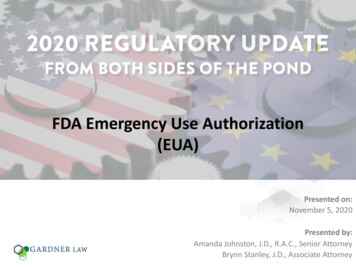
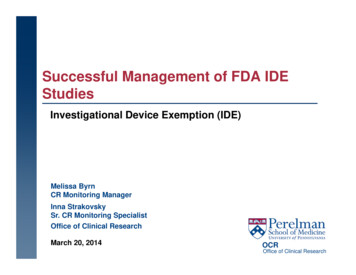
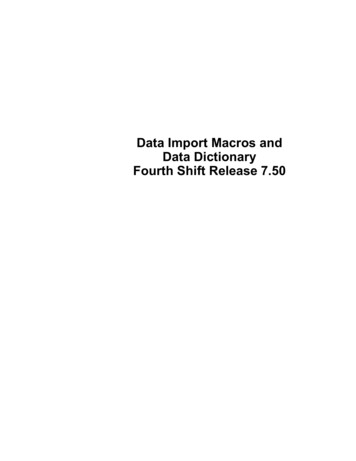
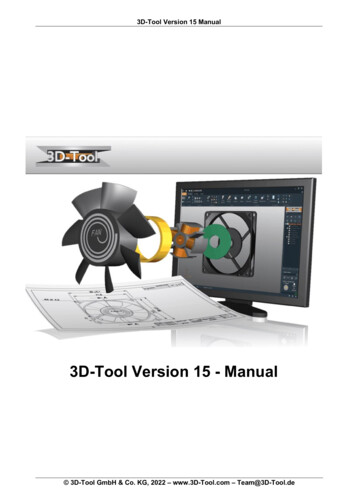

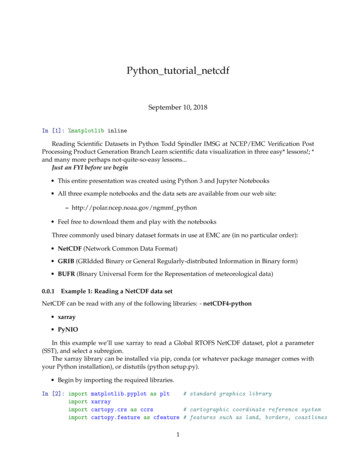
![Lab 006-007 - [NEW] Matlab Data Analysis and Toolbox](/img/25/lab-006-007-new-matlab-data-analysis-and-toolbox-simulink.jpg)

